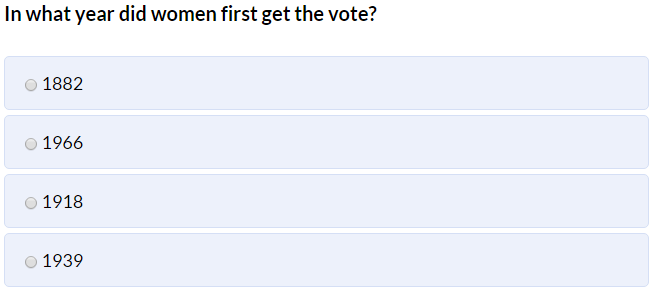We have compiled a list of commonly asked questions to help answer any questions you may have about the Life in the UK test. If you do not find the answer to your question here, please contact us and we will be very happy to help you.
The Life in the UK test consists of 24 questions about important aspects of life in the UK today. You will take your test on a computer, and have 45 minutes to complete all the questions. In order to pass the test, you have to answer 18 questions correctly. The questions are based on ALL parts of Life in the United Kingdom: A Guide for New Residents.
You can only take your test at a registered and approved test centre, and you can only book your test online at www.lifeintheuktest.gov.uk
There are four types of question in the test. Each practice test contains examples of each of these types of question, presented in random order.
1) The first type of question involves selecting one correct answer from four options. Here is an example of this type of question (the correct answer will appear in GREEN when selected).

2) The second type of question involves deciding whether a statement is true or false. Here is an example of this second type of question.

3) The third type of question involves selecting the statement which you think is correct from a choice of two statements. Here is an example of this third type of question.

4) The final type of question involves selecting two correct answers from four options. You need to select both correct answers to get a point on this type of question. Here is an example of this fourth type of question.

To pass the Life in the UK test, you need to read and understand ALL chapters in Life in the United Kingdom: A Guide for New Residents (4th edition). The chapters cover a range of topics you will need to know as a permanent resident or citizen of the UK:
The questions in the Life in the UK test are written at a level of English equivalent to English for Speakers of Other Languages (ESOL) Entry Level 3. The English language requirements for permanent residence or citizenship may change from time to time. You can check the current requirements on the UK Visas and Immigration website at: https://www.gov.uk/government/organisations/uk-visas-and-immigration
Here are a few techniques which might help you to study.
When to study
Check your understanding
Make notes
Practice questions
Revision
If you find revision difficult, ask a friend or family member to test you on the information in your notes or directly from the guide.
You can only book your test online at: www.lituktestbooking.co.uk
You cannot book the test by post or by any other means. You should not take your test at any other establishment, as the UK Border Agency will only accept certificates from registered test centres.
The earliest you can take a test is seven days from the date of booking.
You can only take the test at a registered and approved Life in the UK test centre. There are about 60 test centres around the UK. You will be given details of your nearest test centre when you book.
The test costs £50. You must pay this online with a debit or credit card when you book your test.
You must bring photographic identification (ID) with you to the test centre to show to the test supervisor. You will not be allowed to take the test without your photographic ID.
You must bring one of the following forms of ID:
You will also need to bring proof of your postcode. This should be an original (not a photocopy) of one of the following documents:
The documents you can use may change in the future. You should check the UK Visas and Immigration website for up-to-date information at https://www.gov.uk/government/organisations/uk-visas-and-immigration.
You will be asked about your needs when you book your test. The test centre will make the necessary arrangements to give you the support you need so you can complete the test.
You take the test using a computer. You will have 45 minutes to do the test. This gives you plenty of time to choose your answers and check them again before the end. You do not need to rush to finish the test quickly. Use all of the time that you are given. Headphones are available for you to listen to the questions and answer options.
When you arrive at the test centre, you will need to present the supervisor with the ID you registered with and a document showing proof of your postcode. You won’t be able to take your test if you don’t have these documents with you.
The supervisor will check your documents and, once verified, you will be logged on to a computer.
You can take a practice test so that you can practise answering questions with the mouse and moving from one question to another. This practice test does not affect your final result in the real test.
When you are ready, the supervisor will tell you when you can begin your test and how long you have to complete it.
You will not be allowed to look at books or any notes you have made, and you will not be able to use any electronic device, such as a mobile phone, bluetooth headphones or palm pilot. If you are caught cheating, your test will be stopped immediately.
If you pass the test, the test supervisor will give you a Pass Notification Letter that you must sign. The letter contains details of your test date, supervisor, centre location and a unique ID number.
You will need the Pass Notification Letter when you apply for citizenship or permanent residence, so it is very important to keep it safe.
When you have completed your application for citizenship or permanent residence, you need to attach your Pass Notification Letter and send both documents to the Home Office. The Home Office will keep the information it gets from test centres for a reasonable period of time. However, you should send in your application as soon as possible after taking the test.
Your test supervisor will tell you if you have failed the test and will give you a Results Notification Letter. In this case you will need to take the test again. You will need to book and pay for another appointment and you will have to wait for at least seven days before you can retake the test.
You can take the test as many times as you need to. You cannot make an application for naturalisation as a British citizen or for indefinite leave to remain until you have passed the test.
If you feel you did not pass the test because of your level of English, you may want to think about going to combined English language (ESOL) and citizenship classes at your local further education college or adult education centre. If you do a course and get a certificate, you may not have to take the test again. English language requirements for settlement or citizenship may change and you should always check the up-to-date position on the UK Border Agency website.
If your application for citizenship is successful, the Home Office will send you a letter confirming this and inviting you to attend a ceremony. Your ceremony will usually be close to where you live. If you want your ceremony to be somewhere else in the UK, you need to make this clear when you make your application for naturalisation.
When you receive your invitation to a ceremony, you have 90 days to attend one. Your invitation will include contact details for the local authority or council that will organise your ceremony. The ceremony usually takes place at a register office or town hall, but it may take place in another public or community building.
You will usually be able to take two guests with you to the ceremony. Attendance at the ceremony is by invitation only.
It is also possible to arrange a private ceremony. You should discuss this with your local authority. You may have to pay an extra fee to arrange a private ceremony.
When you attend your ceremony, you must make an oath of allegiance (or you can make an affirmation if you prefer not to swear by God) and a pledge. These are the promises you make when you become a British citizen.
When you arrive at the ceremony, the staff will check your identity and confirm that the personal details on your certificate are correct.
During the ceremony, speeches will be made, often by important local or national people. These may include welcoming the new citizens on behalf of the local area and encouraging them to play an active role within their communities.
You will be presented with your certificate of British citizenship and a welcome pack. Sometimes new citizens receive a small gift from the council. All new citizens are invited to stand while the National Anthem is played.
Some local authorities arrange for photographs or videos of the event to be taken. You will be able to buy these if you would like to.